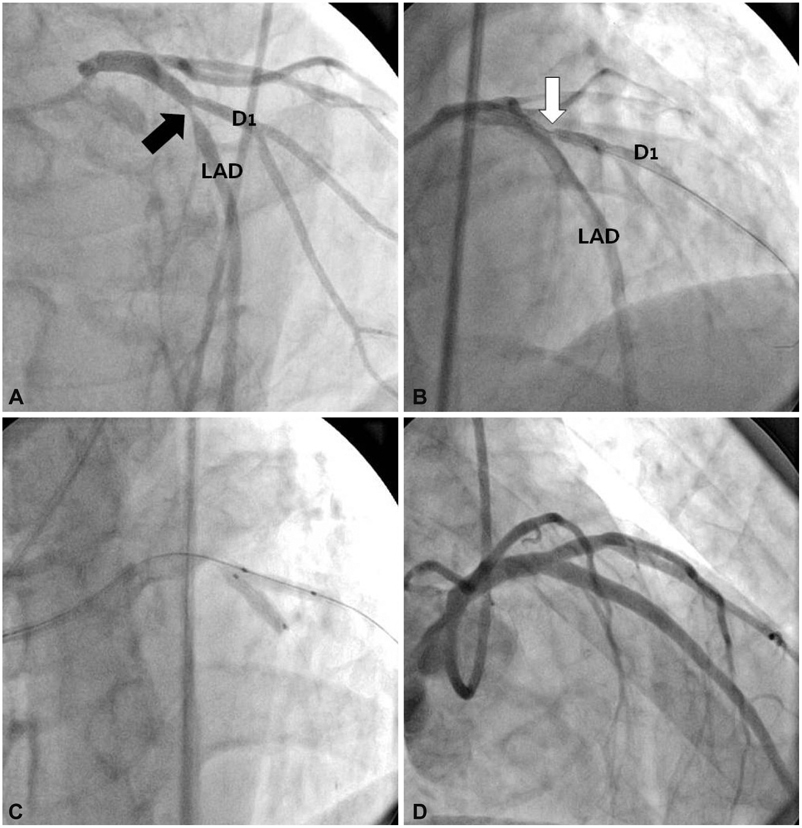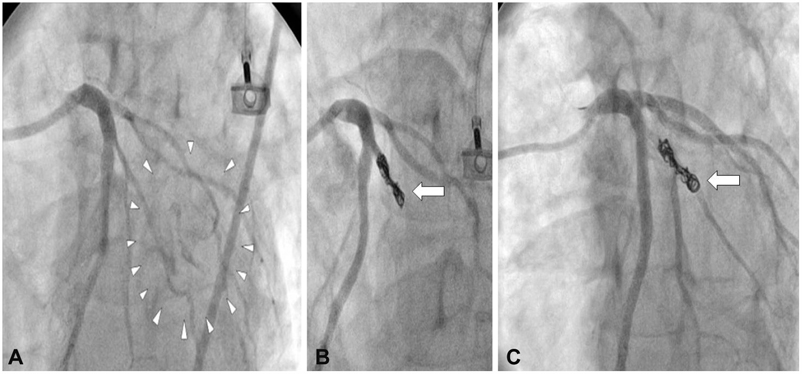Korean Circ J.
2011 Aug;41(8):474-478. 10.4070/kcj.2011.41.8.474.
Is a Metallic Microcoil Really a Permanent Embolic Agent for the Management of Distal Guidewire-Induced Coronary Artery Perforation?
- Affiliations
-
- 1Division of Cardiology, Department of Internal Medicine, Hallym University Medical School, Hangang Sacred Heart Hospital, Seoul, Korea. cagkim@hanmail.net
- KMID: 1826356
- DOI: http://doi.org/10.4070/kcj.2011.41.8.474
Abstract
- Coronary artery perforation (CAP) after percutaneous coronary intervention is a rare, but serious complication. It can cause cardiac tamponade, acute myocardial infarction or death. The treatments of CAP involve prolonged balloon inflation, emergent surgery, coil embolization, and implantation of covered stent. We have successfully performed the emergent microcoil embolization in a patient with uncontrolled Ellis grade 3 guidewire-induced CAP resulting in delayed cardiac tamponade. Contrasting our usual expectation, the 1-year follow-up angiography showed a patent flow at the embolized site.
MeSH Terms
Figure
Reference
-
1. Gruberg L, Pinnow E, Flood R, et al. Incidence, management, and outcome of coronary artery perforation during percutaneous coronary intervention. Am J Cardiol. 2000. 86:680–682.2. Dippel EJ, Kereiakes DJ, Tramuta DA, et al. Coronary perforation during percutaneous coronary intervention in the era of abciximab platelet glycoprotein IIb/IIIa blockade: an algorithm for percutaneous management. Catheter Cardiovasc Interv. 2001. 52:279–286.3. Fukutomi T, Suzuki T, Popma JJ, et al. Early and late clinical outcomes following coronary perforation in patients undergoing percutaneous coronary intervention. Circ J. 2002. 66:349–356.4. Gunning MG, Williams IL, Jewitt DE, Shah AM, Wainwright RJ, Thomas MR. Coronary artery perforation during percutaneous intervention: incidence and outcome. Heart. 2002. 88:495–498.5. Fasseas P, Orford JL, Panetta CJ, et al. Incidence, correlates, management, and clinical outcome of coronary perforation: analysis of 16,298 procedures. Am Heart J. 2004. 147:140–145.6. Stankovic G, Orlic D, Corvaja N, et al. Incidence, predictors, in-hospital, and late outcomes of coronary artery perforations. Am J Cardiol. 2004. 93:213–216.7. Witzke CF, Martin-Herrero F, Clarke SC, Pomerantzev E, Palacios IF. The changing pattern of coronary perforation during percutaneous coronary intervention in the new device era. J Invasive Cardiol. 2004. 16:257–301.8. Javaid A, Buch AN, Satler LF, et al. Management and outcomes of coronary artery perforation during percutaneous coronary intervention. Am J Cardiol. 2006. 98:911–914.9. Kiernan TJ, Yan BP, Ruggiero N, et al. Coronary artery perforations in the contemporary interventional era. J Interv Cardiol. 2009. 22:350–353.10. Gaxiola E, Browne KF. Coronary artery perforation repair using microcoil embolization. Cathet Cardiovasc Diagn. 1998. 43:474–476.11. Aslam MS, Messersmith RN, Gilbert J, Lakier JB. Successful management of coronary artery perforation with helical platinum microcoil embolization. Catheter Cardiovasc Interv. 2000. 51:320–322.12. Assali AR, Moustapha A, Sdringola S, Rihner M, Smalling RW. Successful treatment of coronary artery perforation in an abciximab-treated patient by microcoil embolization. Catheter Cardiovasc Interv. 2000. 51:487–489.13. Banerjee S, Egdell R, Watkinson A, Greenbaum R. Coronary artery rupture treated with microcoil occlusion. Heart. 2001. 86:187.14. Mahmud E, Douglas JS Jr. Coil embolization for successful treatment of perforation of chronically occluded proximal coronary artery. Catheter Cardiovasc Interv. 2001. 53:549–552.15. Katsanos K, Patel S, Dourado R, Sabharwal T. Lifesaving embolization of coronary artery perforation. Cardiovasc Intervent Radiol. 2009. 32:1071–1074.16. Georgiadou P, Karavolias G, Sbarouni E, Adamopoulos S, Malakos J, Voudris V. Coronary artery perforation in patients undergoing percutaneous coronary intervention: a single-centre report. Acute Card Care. 2009. 11:216–221.17. Kini AS, Rafael OC, Sarkar K, et al. Changing outcomes and treatment strategies for wire induced coronary perforations in the era of bivalirudin use. Catheter Cardiovasc Interv. 2009. 74:700–707.18. Ramana RK, Arab D, Joyal D, et al. Coronary artery perforation during percutaneous coronary intervention: incidence and outcomes in the new interventional era. J Invasive Cardiol. 2005. 17:603–605.19. Wong CM, Kwong Mak GY, Chung DT. Distal coronary artery perforation resulting from the use of hydrophilic coated guidewire in tortuous vessels. Cathet Cardiovasc Diagn. 1998. 44:93–96.20. Von Sohsten R, Kopistansky C, Cohen M, Kussmaul WG 3rd. Cardiac tamponade in the "new device" era: evaluation of 6999 consecutive percutaneous coronary interventions. Am Heart J. 2000. 140:279–283.
- Full Text Links
- Actions
-
Cited
- CITED
-
- Close
- Share
- Similar articles
-
- Guidewire-Induced Perforation of Distal Circumflex Artery Treated with Transcatheter Embolization of Polyvinyl Alcohol Form
- Simple Management of Radial Artery Perforation during Transradial Percutaneous Coronary Intervention
- Four Cases of Guidewire Induced Periampullary Perforation During Endoscopic Retrograde Cholangiopancreatography
- Prevention of Coronary Artery Perforation and Its Treatment During CTO PCI: Study of Effective Coiling for Distal and Collateral Perforations
- Fatal Subacute Stent Thrombosis Induced by Guidewire Fracture with Retained Filaments in the Coronary Artery



